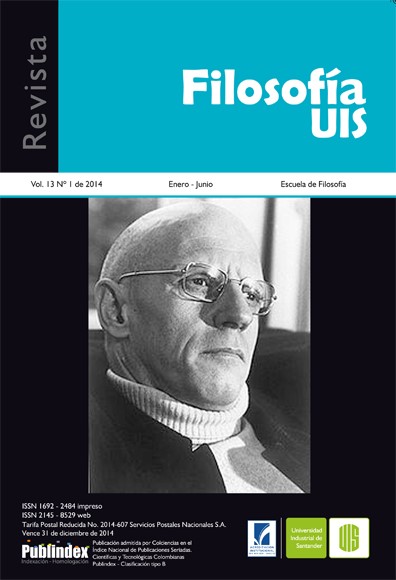The melancholy of the angel and the prophet. (Or about the general principles for a critique of liberal stanza)
Published 2014-04-29
Keywords
- Melancholy,
- compulsion,
- regime,
- space,
- event
How to Cite
Copyright (c) 2014 Camilo Alfonso Salazar Flórez

This work is licensed under a Creative Commons Attribution 4.0 International License.
Abstract
The main purpose of this essay is trying to relate agambeniana theory of human melancholic “estancia”, in which is defined symbolic plurality, to a conception of melancholy ruled by the inherent spaciality to such syndrome, in search of point out a melancholic analogy (a silent discourse) with the liberalism. It is shown how and why this sickness is related, from the beginning, to the space and how such sickness does not have an other option but being the specialiation of everything that wants to show through it. Afther that, it is defined how certain hysterias reflect melancholyc regime and how its cure can not be presented in the same regime but through its breakdown (breakdown will not be explained as something behind issues but as something on the surface of such issues). With all of this clear, it is made a specific review of Agamben’s theory of Angel and Prophet as melancholyc actions, and finally facing them against presence of Christ, as that which, living in reality’s hearth, can be the fulminant and generative event of that.
Downloads
References
- Agamben, G. (2001). Estancias: La palabra y el fantasma en la cultura occidental. T. Segovia (trad.). Valencia: Pre-Textos.
- Agamben, G. (2011). “Creación y salvación”. Giorgio Agamben. Desnudez. Buenos Aires: Adriana Hidalgo Editores.
- Benjamin, W. (2006). “El origen del ‘trauerspiel’ alemán”. Walter Benjamin. Obras. Libro I. Madrid: Abada.
- Benjamin, W. (2006a). “El concepto de crítica de arte en el Romanticismo alemán”. Walter Benjamin. Obras. Libro I. Madrid: Abada.
- Benjamin, W. (2007). “Metafísica de la juventud”. Walter Benjamin. Obras. Libro II. Madrid: Abada.
- Benjamin, W. (2007a). “Trauerspiel y Tragedia”. Walter Benjamin. Obras. Libro II. Madrid: Abada.
- Benjamin, W. (2007b). “Sobre el lenguaje en cuanto tal y sobre el lenguaje del hombre”. Walter Benjamin. Obras. Libro II. Madrid: Abada.
- Benjamin, W. (2007c). “Hacía la crítica de la violencia”. Walter Benjamin. Obras. Libro II. Madrid: Abada.
- Echeverría, B. V. (2000). La modernidad de lo barroco. México: Era.
- Freud, S. (2008). “La interpretación de los sueños”. Sigmund Freud. Obras completas, Buenos Aires: El Ateneo.
- Freud, S. (2008a). “Duelo y melancolía”. Sigmund Freud. Obras completas. Buenos
- Aires: El Ateneo
- Freud, S. (2008b). “Los actos obsesivos y las prácticas religiosas”. Sigmund Freud. Obras completas. Buenos Aires: El Ateneo.
- Hegel, G. W. F. (2006). Fenomenología del espíritu. Valencia: Pre-Textos.
- Kristeva, J. (1997). Sol negro. Depresión y melancolía. Caracas: Monte Ávila.
- Kierkegaard, S. (2004). Tratado de la desesperación. Buenos Aires: Leviatán.
- Lear, J. (1998). Open Minded. Working out the Logic of the Soul. Cambridge:
- Harvard University Press.
- Lear, J. (2005). Freud. Nueva York, Londres: Routledge.
- Mosès, S. (2007). El Eros y la Ley: Lectura bíblicas. Buenos Aires: Katz.
- Panofsky, E.; Saxl, F. y Klibansky, R. (1991). Saturno y la melancolía: estudios de la historia de la filosofía, la naturaleza, la religión y el arte. Madrid: Alianza.
- Saal, F. (2005). “Algunas consecuencias políticas de la diferencia psíquica de los sexos”. N. Braunstein (ed.). A medio siglo de El malestar en la cultura de Sigmund Freud. Buenos Aires: Siglo XXI.
- SAGRADA BIBLIA (1994). Texto de la edición impresa en 1884 traducida de la Vulgata Latina al Español. Barcelona: Prolibros.
- Salazar, C. (2013). La voz o la flatulencia. En el temprano concepto de luto/ melancolía de Walter Benjamin. Tesis de Maestría en Filosofía. Pontificia Universidad Javeriana.
- Santner, E. (2001). On the Psychotheology of Everyday Life. Reflections on Freud and Rosenzweig. Chicago: The University of Chicago Press.
- Sarduy, S. (1974). Barroco. Buenos Aires: Sudamericana.
- Schelling, F. W. J. (1989). Investigaciones filosóficas sobre la esencia de la libertad humana y los objetos con ella relacionados. Barcelona: Anthropos.
- Scholem, G. (1996). Las grandes tendencias de la mística judía. México: Fondo de Cultura Económica.
- Zizek, S. (1992). El sublime objeto de la ideología. México: Siglo XXI.
